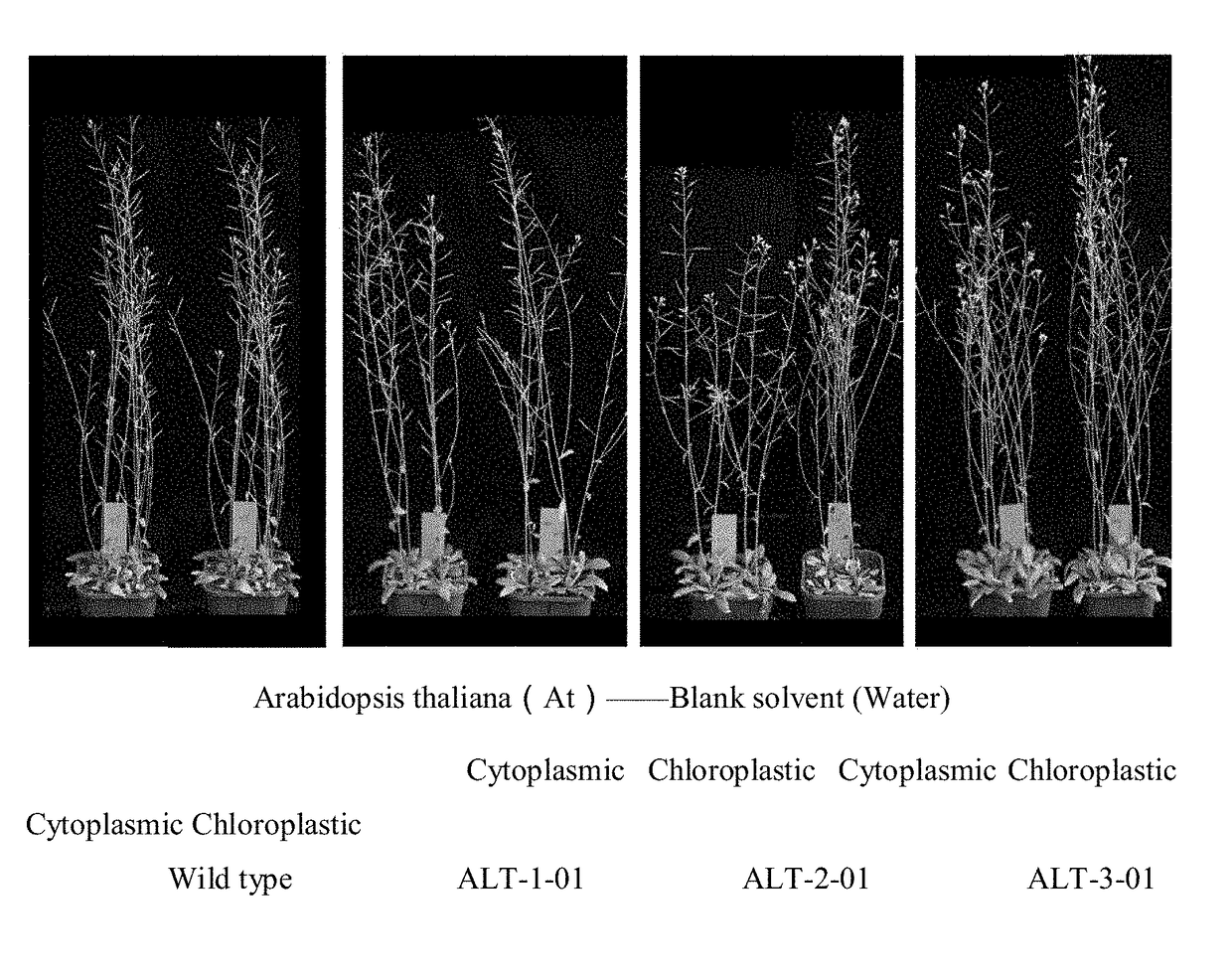Use of Herbicide-tolerant Protein
- Summary
- Abstract
- Description
- Claims
- Application Information
AI Technical Summary
Benefits of technology
Problems solved by technology
Method used
Image
Examples
example 1
on and Synthesis of an ALT Gene Sequence
[0151]1. Acquisition of an ALT Gene Sequence
[0152]The amino acid sequence (398 amino acids) of thifensulfuron hydrolase-1 (ALT-1) is shown as SEQ ID NO: 1 in the sequence listing; the ALT-1-01 nucleotide sequence (1197 nucleotides) encoding the corresponding ALT-1 amino acid sequence is shown as SEQ ID NO: 2 in the sequence listing; and the ALT-1-02 nucleotide sequence (1197 nucleotides) encoding the corresponding ALT-1 amino acid sequence is shown as SEQ ID NO: 3 in the sequence listing.
[0153]The amino acid sequence (369 amino acids) of thifensulfuron hydrolase-2 (ALT-2) is shown as SEQ ID NO: 4 in the sequence listing; the ALT-2-01 nucleotide sequence (1110 nucleotides) encoding the corresponding ALT-2 amino acid sequence is shown as SEQ ID NO: 5 in the sequence listing; and the ALT-2-02 nucleotide sequence (1110 nucleotides) encoding the corresponding ALT-2 amino acid sequence is shown as SEQ ID NO: 6 in the sequence listing.
[0154]The amino...
example 5
Unexpected Technical Effect on Different Sulfonylurea Herbicides
[0185]The thifensulfuron hydrolase, which can also be known as sulfonylurea herbicide de-esterase, degrades ester bond-containing sulfonylurea herbicides (e.g., thifensulfuron, etc.) into herbicidally inactive mother acids by hydrolyzing the ester bond, and therefore it cannot degrade ester bond-free sulfonylurea herbicides (e.g., nicosulfuron, chlorsulfuron, etc.). In the prior art, there are many sulfonylurea herbicides containing ester bonds and having similar structures, such as tribenuron-methyl, iodosulfuron-methyl, oxasulfuron, mesosulfuron (mesosulfuron-methyl), pyrazosulfuron-ethyl, sulfometuron-methyl, and halo sulfuron-methyl.
[0186]At cytoplasmic ALT-1-01 T1 plants, At chloroplastic ALT-1-01 T1 plants, At cytoplasmic ALT-2-01 T1 plants, At chloroplastic ALT-2-01 T1 plants, At cytoplasmic ALT-3-01 T1 plants, At chloroplastic ALT-3-01 T1 plants and wild-type Arabidopsis thaliana plants in Example 4 were sprayed...
example 7
on and Verification of Transgenic Soybean Plants
[0199]1. Acquisition of Transgenic Soybean Plants
[0200]According to the Agrobacterium infection method conventionally used, the cotyledonary node tissue of a sterile culture of soybean variety Zhonghuang13 was co-cultured with the Agrobacterium in point 2 of Example 6, so as to introduce T-DNA (comprising the Arabidopsis thaliana Ubiquitin10 gene promoter sequence, an ALT-1-01 nucleotide sequence, an ALT-2-01 nucleotide sequence, an ALT-3-01 nucleotide sequence, the tNos terminator, the rape eukaryotic elongation factor gene 1a promoter, the Arabidopsis thaliana chloroplast transit peptide, 5-enolpyruvylshikimate-3-phosphate synthase gene and the pea RbcS gene terminator) in the recombinant expression vectors DBN100828, DBN100827, DBN100826, DBN100825, DBN100824 and DBN100823 constructed in Example 6.1 into the soybean chromosomes, obtaining soybean plants that were transformed with the recombinant expression vector DBN100828 and had a...
PUM
| Property | Measurement | Unit |
|---|---|---|
| Time | aaaaa | aaaaa |
| Area | aaaaa | aaaaa |
| Area | aaaaa | aaaaa |
Abstract
Description
Claims
Application Information
 Login to View More
Login to View More - R&D
- Intellectual Property
- Life Sciences
- Materials
- Tech Scout
- Unparalleled Data Quality
- Higher Quality Content
- 60% Fewer Hallucinations
Browse by: Latest US Patents, China's latest patents, Technical Efficacy Thesaurus, Application Domain, Technology Topic, Popular Technical Reports.
© 2025 PatSnap. All rights reserved.Legal|Privacy policy|Modern Slavery Act Transparency Statement|Sitemap|About US| Contact US: help@patsnap.com



